The rings are really closing up this season. The north polar region is now clearly visible, but it makes resolution of the rings much more difficult.
The images are in chronological order, so the best may well be at the bottom.
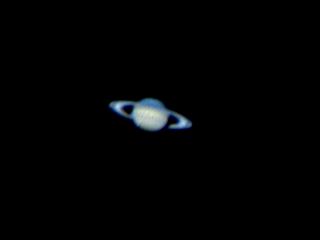 |
My first picture of the season. Saturn was still low in the early-morning sky (34°) when this picture was taken only an hour and a quarter before sunrise. It was 1,456 million kilometres (9.73 AU) away and subtended an angle of 17 arc-seconds.
Date and Time: 8th October 2006 05:00 UT
Camera: ToUcam 740K
Telescope: LX200 at prime focus
Capture: K3CCDTools. Low gamma, high saturation, 1/33", 52% gain, 630 frames
Processing: Registax. 4 alignment points, 296 frames stacked, wavelets 1-2 = 10, histogram 20-160.
|
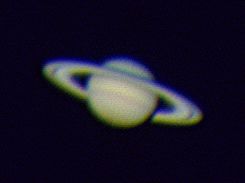 |
My second picture of the season, taken only 9 days later, but with my X2 lens. Saturn was still low in the early-morning sky (37°) when this picture was taken only an hour and a half before sunrise.
Date and Time: 17th October 2006 04:51 UT
Camera: ToUcam 740K
Telescope: LX200 with X2 lens
Capture: K3CCDTools. 50% gamma, high saturation, 1/25", 58% gain, 632 frames
Processing: Registax. 2 alignment points, 449 frames stacked, wavelets 1-2 = 10, contrast 200, brightness -24, blue component reduced to balance the histograms.
|
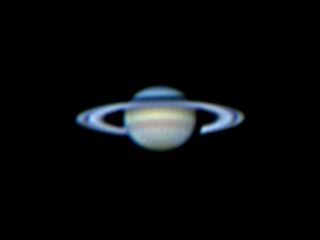 |
This picture was taken 2 weeks later. I've processed two AVI files in two ways using RegiStax. The base image is processed much as I usually do, but the mouseover image is processed using Gaussian wavelets and a trick that removes the noise by isolating it in the smallest wavelet. I leave you to judge how well it works.
Date and Time: 2nd November 2006 05:17 (base) 05:13 (mouseover) UT
Camera: ToUcam 740K
Telescope: LX200 with X2 lens
Capture: K3CCDTools. Low gamma, high saturation, 1/25", 27% gain, 1007 frames
Processing: Registax. 4 alignment points.
Base image: 791 frames stacked, wavelets 1-3 = 10, gamma 0.8, contrast 200, brightness -16.
Mouseover: 157 frames stacked, wavelet 1 @ 0.2 = off, wavelets 2-3 @ 0.15 = 10, gamma 0.8.
|
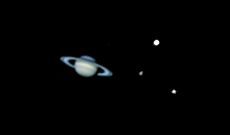 |
And now Saturn with three of his satellites. Move your mouse over the image to see which is which. It is a composite image, a low gain for the planet and a high one for the satellites.
Date and Time: 2nd November 2006 04:48 and 05:13 UT
Camera: ToUcam 740K (planet) and Atik ATK 1-HS (satellites)
Telescope: LX200 with 0.33 focal reducer
Capture: K3CCDTools. High gamma, B/W, 1/25", 100% gain, 449 frames
Processing: Registax. 3 alignment points, 244 frames stacked, gaussian wavelets 1 @ 0.24 = off, 2 @ 0.14 = 20
|
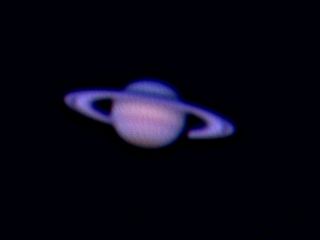 |
A single image made under difficult conditions with heavy dewing of the telescope.
Date and Time: 24th November 2006 06:05 UT
Camera: ToUcam 740K
Telescope: LX200 with X2 lens
Capture: K3CCDTools. Low gamma, high saturation, 1/25", 60% gain, 1036 frames
Processing: Registax. 609 frames stacked, wavelets 1-3 = 10, contrast 160, brightness -20, histogram 0-190
|
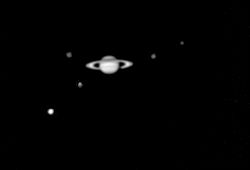 |
This picture was taken 2 days later. Conditions did not support long focal lengths, but I had my focal reducer fitted and I was able to capture five of the satellites. (A sixth, Hyperion, was in frame but too faint for my camera.) Move your mouse over the picture to see which is which. This is a composite of two exposures using my raw-modified Atik monochrome camera.
Date and Time: 26th November 2006 03:08 and 03:15 UT
Camera: Atik ATK-1 HS
Telescope: LX200 with 0.33 focal reducer
Capture: K3CCDTools. Satellites: High gamma, high saturation, 1/2", 70% gain, 108 frames
Planet: Low gamma, high saturation, 1/25", 19% gain, 455 frames
Processing: Registax. Satellites: 92 frames stacked, wavelets 1-2 = 10.
Planet: 92 frames stacked, wavelets 1-2 = 10.
|
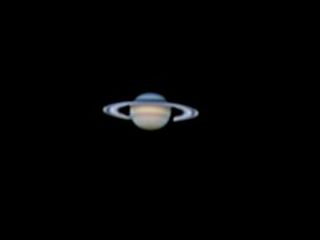 |
At last a clear, if windy, morning and I was able to get the next three pictures.
Date and Time: 12th December 2006 03:38 UT
Camera: ToUcam 740K
Telescope: LX200 at prime focus
Capture: K3CCDTools. Low gamma, high saturation, 1/25", 20% gain, 1314 frames
Processing: Registax. 873 frames resampled X2 and stacked, wavelets 1-2 = 10, and then resized to 50% in PhotoImpact.
|
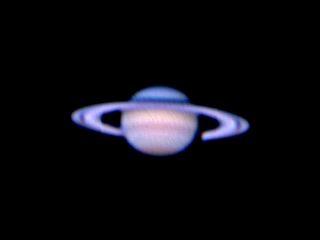 |
Taken the same night as the picture above but with my X2 adaptor lens.
Date and Time: 12th December 2006 06:10 UT
Camera: ToUcam 740K
Telescope: LX200 with X2 lens
Capture: K3CCDTools. Low gamma, high saturation, 1/25", 60% gain, 1052 frames
Processing: Registax. 930 frames stacked, wavelets 1-2 = 10, histogram 0-220
Satellites: 873 frames stacked, wavelets 1-3 = 10, histogram 15-190.
|
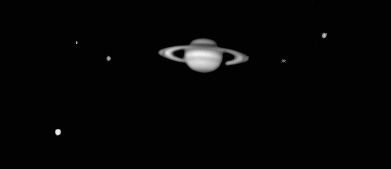 |
And lastly for the 12th of December, a picture with five satellites (move your mouse over to see which is which). This is a composite of two images taken with my monochrome Atik camera.
Date and Time: 12th December 2006 05:24 and 05:33 UT
Camera: Atik ATK-1 HS
Telescope: LX200 at prime focus
Capture: K3CCDTools. Planet: Low gamma, high saturation, 1/33", 12% gain, 615 frames
Satellites: High gamma, high saturation, 1/25", 100% gain, 584 frames
Processing: Registax. Planet: 389 frames, wavelets 1-2 = 10, gamma 0.8, contrast 125
Satellites: 373 frames, wavelets 1-2 = 10, gamma 1.5, brightness -34.
|
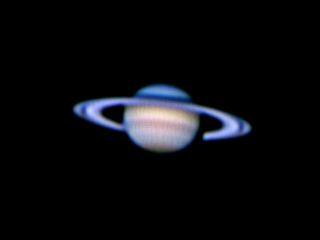 |
The last image from 2006 and the best so far. Saturn was due south at an altitude of 52°. It was 1,293 million kilometres away (8.642 AU) and subtended an angle of 19 arc-seconds.
Date and Time: 17th December 2006 04:12 UT
Camera: ToUcam 740K
Telescope: LX200 with X2 lens
Capture: K3CCDTools. Low gamma, high saturation, 1/25", 65% gain, 1753 frames
Processing: Registax. 2 alignment points, 1459 frames, wavelets 1-2 = 10, sigmoid gamma.
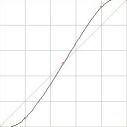
|
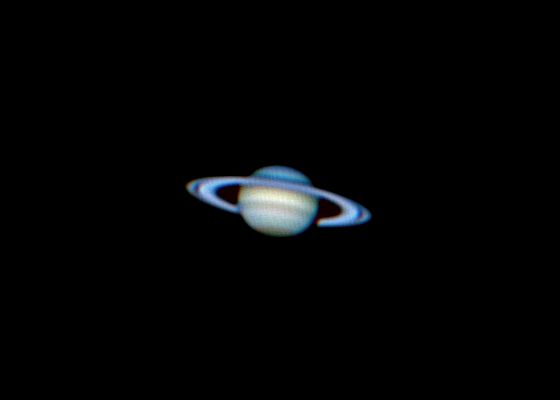 |
Taken a few minutes before the picture below, Saturn in colour with my X2 lens and Toucam 740K.
Move your mouse over the image to see a monochrome image taken with the Atik camera. (The slight change in scale is caused by a small, unavoidable difference in the distance from the lens to the camera.)
Date and Time: 14th January 2007 23:56 (Mono) and 15th January 00:27 UT (colour)
Camera: Toucam 740K and Atik ATK-1 HS
Telescope: LX200 with X2 lens
Capture: K3CCDTools.
Colour: Low gamma, high saturation, 1/25", 57% gain, 773 frames
Mono: Low gamma, high saturation, 1/25",
50% gain, 422 frames
Processing: Registax.
Colour: 697 frames, wavelets 1 = 10, 2 = 20, histogram 40-180, colours auto-balanced
Mono: 296 frames, wavelets 1 = 10, 2 = 60
|
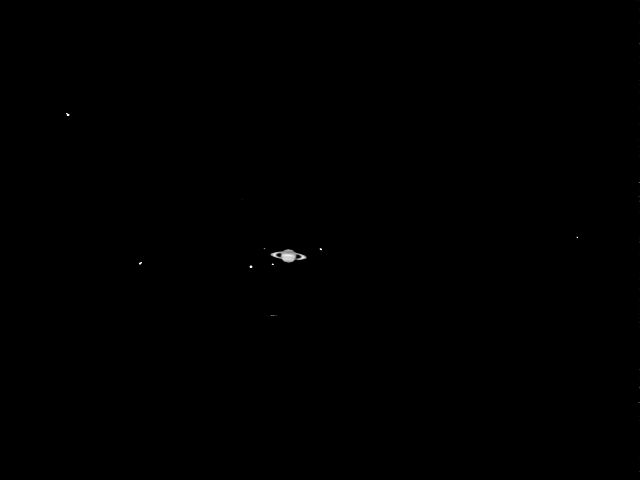 |
The first image of 2007 is my best picture so far of Saturn with six of his satellites. Never before have I managed to image one so close to the planet. It is, of course, a composite of two images, one of the planet and one of the satellites. The tricky bit was resolving the satellites from the glare of the over-exposed planet, removing the over-exposed area without losing the satellites and pasting in the correctly-exposed planet in the right place. The satellites had the following magnitudes: Titan 8.1, Rhea 9.5, Enceladus 11.5, Tethys 10.0, Dione 10.2, Iapetus 10.9. Hyperion was also within the frame (about halfway between Iapetus and Saturn) but, at magnitude 14.0, it was too faint for my camera.
Saturn was 1,243 million kilometres away (8.311 AU) and subtended an angle of 19 arc-seconds.
Date and Time: 14th January 2007 22:49 and 22:52 UT
Camera: Atik ATK-1 HS
Telescope: LX200 with 0.33 focal reducer
Capture: K3CCDTools.
Satellites: Low gamma, high saturation, 1/50", 100% gain, 334 frames
Planet: Low gamma, high saturation, 1/100", 0% gain, 324 frames
Processing: Registax.
Satellites: 328 frames, wavelet 1 = 100
Planet: 281 frames, wavelets 1 = 10, 2 = 5
|
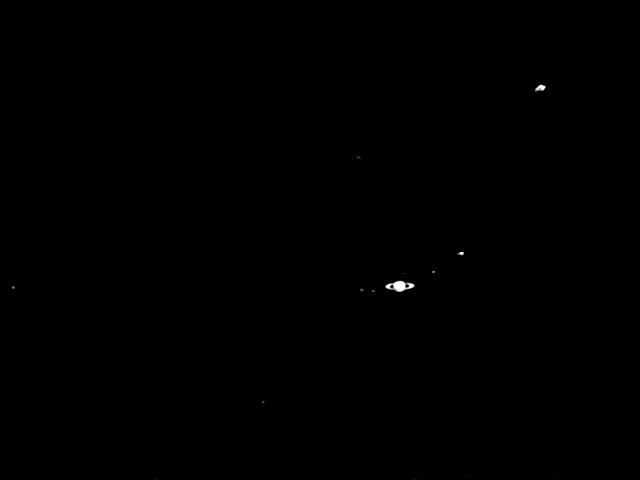 |
Another picture of the satallites take on 25th March. This time I have included the magnitudes of the satellites and a few nearby stars in the mouseover image. It is, of course, a composite of two exposures.
Saturn was 1,268 million kilometres away (8.479 AU) and subtended an angle of 19 arc-seconds.
Date and Time: 25th March 2007 23:24 UT
Camera: Atik ATK-1 HS
Telescope: LX200 with 0.33 focal reducer
Capture: K3CCDTools. High gamma, 1/25", 80% gain, 323 frames
Processing: Registax. 278 frames, wavelet 1-2 = 10
|
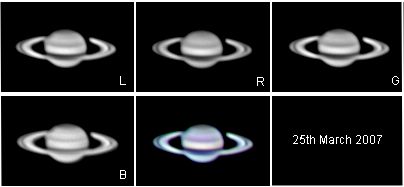 |
My first attempt to image Saturn by the LRGB technique. Four avi files were taken using my Atik monochrome camera and the Astronomik LRGB filters. The R, G, and B images were combined to produce a colour picture, and then combined with the L image (the L filter is a simple IR-block filter) to produce the LRGB final image. The top picture shows the four separate pictures and the composite. (I'm sorry these are up side down!)
The second picture is the LRGB image turned the right way up and enlarged X2.
The bottom image was made using my Toucam 740K also enlarged X2.
Date and Time: 25th March 2007 20:25 (Toucam) and 22:48 to 22:58 UT
Camera: Toucam 740K and Atik ATK-1 HS
Telescope: LX200 at prime focus
Capture: K3CCDTools. Toucam: low gamma, high saturation, 1/33", 45% gain, 418 frames
Atik not recorded (QcamLog failed for some reason)
Processing: Registax. Waveletd 1-2 = 10, contrast 110 - 140, histogram stretched slightly.
|
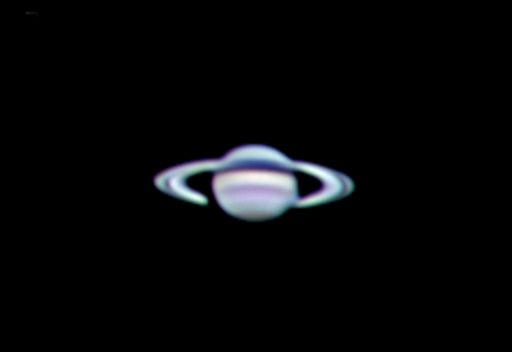 |
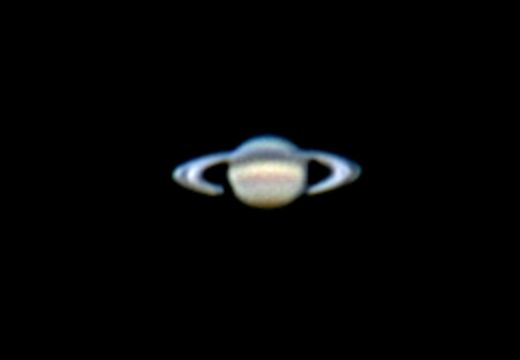 |
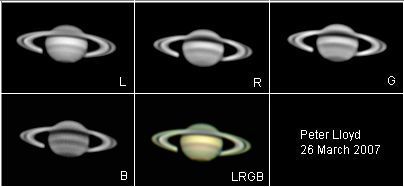 |
This is my second attempt at LRGB imaging on Saturn.
The upper picture here shows the four individual pictures and the composite as imaged. The lower picture is the LRGB image magnified X2.
Date and Time: 26th March 2007 20:36 to 20:40 UT
Camera: Atik ATK-1 HS
Telescope: LX200 at prime focus
Capture: K3CCDTools.
Processing: Registax. L image 249 frames, wavelets 1-2 = 10, histogram 0-230
|
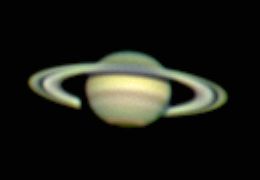 |
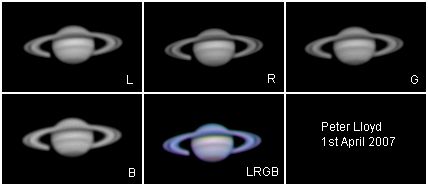 |
This is my next attempt at LRGB imaging on Saturn.
The upper picture here shows the four individual pictures and the composite as imaged. The lower picture is the LRGB image magnified X2 and enhanced with an unsharp mask.
Date and Time: 1st April 2007 20:00 to 20:13 UT
Camera: Atik ATK-1 HS
Telescope: LX200 at prime focus
Capture: K3CCDTools.
Processing: Registax. L image 249 frames, wavelets 1-2 = 10
|
 |
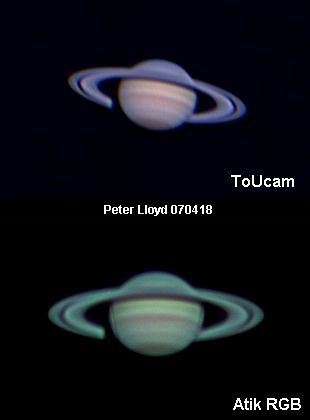 |
Finally, for this season, a direct comparison between LRGB imaging using my raw-modified Atik camera and my colour Toucam 740K. The difference in colour should be ignored—that is caused by my inability to balance the colours the same in the two techniques.
Date and Time: 18th April 2007 20:31 and 21:18 to 21:45 UT
Camera: Toucam 740K and Atik ATK-1 HS
Telescope: LX200 with X2 teleadaptor lens
Capture: K3CCDTools. Low gamma, 1/33", 53% gain, 1320 frames (Toucam)
Low gamma, 1/25", 60% gain, ~1100 frames (Atik)
Processing: Registax. wavelet 1-2 = 10
|

